-
November 12 1746

Birth of Jacques-Alexandre-César Charles
French mathematician, physicist, and inventor. When Benjamin Franklin visited France in 1779, Charles was inspired to study physics. He soon became an eloquent speaker to non-scientific audiences. His lectures and demonstrations attracted notable patrons and helped popularize Franklin's theory of electricity and other new scientific concepts. With Anne-Jean and Nicolas Robert, he made several balloon ascents, and was the first to use hydrogen for balloon inflation (1783). Charles invented most of the equipment that is still used in today's balloons. About 1787 he developed Charles's law concerning the thermal expansion of gases that for a gas at constant pressure, its volume is directly proportional to its absolute temperature.
-
November 21 1783
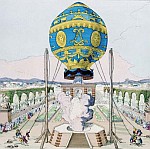
First manned balloon flight
French physician Jean-François Pilatre de Rozier and François Laurent, the marquis d' Arlandes, make the first untethered hot-air balloon before a large, expectant crowd in Paris on November 21. The couple rose up from the grounds of royal Cháteau La Muette in the Bois de Boulogne and flew approximately 5.5 miles over Paris in about 25 minutes. Their cloth balloon was crafted by French papermaking brothers Jacques-Étienne and Joseph-Michel Montgolfier, inventors of the world's first successful hot-air balloons. The Montgolfier brothers were honored by the French Acadámie des Sciences for their achievement.
-
November 30 1784

First free air meteorological observations
In 1784, John Jeffries, an American physician and scientist, recorded the first scientific data for free air, to a height of 9,309-ft, during a balloon flight in London, England for the Prince of Wales and other dignitaries. He flew with Frenchman Jean Pierre Blanchard, who had previous experience in balloon flight. The twelve observations included measurements of temperature, pressure, and humidity. Jeffries' values agree closely with modern determinations. Jeffries had provided himself with thermometer, barometer, electrometer, hygrometer and timepiece. He also took air samples at different elevations for Cavendish, who subsequently made a chemical analysis of the air. This was the first of two balloon flights with Blanchard that Jeffries financed.
-
November 5 1855
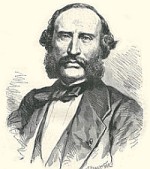
Birth of Léon-Philippe Teisserenc de Bort
French meteorologist who discovered the stratosphere (1902). He established own observatory at Trappes (1896) and pioneered in the use of unmanned, instrumented balloons to investigate atmosphere. Teisserenc de Bort found that above an altitude of 7 miles (11 km) temperature ceased to fall and sometimes increased slightly. He named this upper part of the atmosphere the stratosphere, because he thought that the different gases would lie in distinct strata as, without temperature differentials, there would be no mechanism to disturb them. The lower part of the atmosphere he named the troposphere (Greek: "sphere of change") as here, with abundant temperature differentials, constant change and mingling of atmospheric gases occurred.
-
November 23 1920
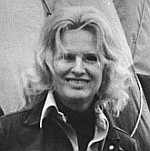
Birth of Vera Habrecht Simons
Was a German/American Aeronaut and artist whom played a very important role in balloon development and exploration. She was born in Germany on November 23, 1920 to Max and Maja Habrecht. After emigrating to United States she was raised in Detroit, Michigan, where in the early 40's she met who will become his second husband, Otto Winzen, considered the father of the modern plastic balloon. In 1949 they founded Winzen Research Inc. which was during many decades the top firm on balloon production in the world. After divorcing Winzen in 1957 she married to Maj. David Simons. She was a very active artist and a consumated aeronaut. These two worlds would mix through a project called "Da Vinci" which were a series of three low altitude balloon flights performed in the 70's decade and other projects and installations in later years. She died in 2012 in Austin, Texas.
-
November 12 1924
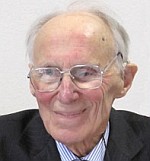
Birth of Audouin Dollfus
Was a French astronomer and aeronaut, specialist in studies of the Solar System and discoverer of Janus, a moon of Saturn. He was born in Paris on November 12, 1924 and was son of Charles Dollfus a French aeronautical pioneer. Dollfus studied at the University of Paris, and worked as an astronomer at the Meudon Observatory. Dollfus was a very active men and always wanted to mix her two passions: aeronautics and astronomy. Thus, in middle 50's he started a project to send a telescope to the stratosphere. The first flight took place in 1954 using a gas balloon and an open basket to achieve -along with his father- an altitude of 7 km. In that opportunity they observed Mars with a spectrometer coupled to a telescope. Later, his efforts were directed toward the construction of a sealed capsule which would allow to reach a greater height, to use a bigger telescope and also transport Dollfus itself inside it. The flight was carried out using a cluster of 103 neoprene balloons in April 1959, from the Villacoublay Air Force Base, attaining a maximum altitude of 14 km. The flight endured 5 hours during which were performed observations of the atmospheric composition of Venus being considered the first and only manned stratospheric flight performed in France. Dollfus died in 2010 at the age of 85.
-
November 9 1925
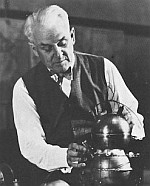
First use of the term "Cosmic Rays"
Robert A. Millikan, an American experimental physicist, confirmed the existence of highly-penetrating radiation from "finite space". The announcement -calling these particles "cosmic rays" for the first time- was made during a lecture to the National Academy of Sciences at Madison, Wisconsin in November 9, 1925. Earlier tests with high-altitude balloons, or atop mountains, remained inconclusive regarding their extra-terrestrial origin. The rays, he thought then, could be of local origin from radioactive materials. However, in 1925, measurements he made up to 27-m below Muir Lake (altitude 3540-m) and Lake Arrowhead (alt. 1530-m) showed rays reached given depths in each by comparable amounts.
-
November 8 1932
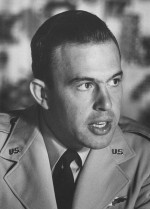
Birth of Lt. Clifton McClure
Clifton "Demi" McClure was a Liutenant of the US Air Force which piloted the third and last manned balloon flight of the Manhigh project in 1958. He was born in Anderson, South Carolina on November 8, 1932. After graduating he entered the Air Force becoming a T-33 instructor pilot. A very curious and active character, he soon was assigned to the AeroMedical Field Laboratoty in Holloman AFB, New Mexico, when he was part of the Manhigh project as second backup pilot for the third flight. After the first pilot suffered a balloon accident while training and the second one was dismissed of the project by medical reasons, he become the official pilot of the last mission of the project. The Manhigh III balloon was launched on October 8, 1958 from Holloman and reached an altitude of 99.700 ft. It was a very troubled mission as McClure had to deal with a failure in the gondola cooling system which made his body temperature rise up to 105º F. After his retirement from the Air Force he became an engineer working many times for NASA. He died on January 14, 2000 at his home in Huntsville, Alabama.
-
November 17 1933
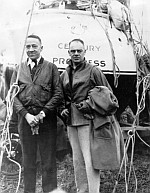
Flight of the "Century of Progress"
On this day, Lt. Commander Thomas G. W. "Tex" Settle (U.S. Navy) and Major Chester L. Fordney (U.S. Marine Corp.) flew in a sealed capsule under a balloon to an altitude of 61,237 feet. The mission was named after the Chicago World's Fair Exposition, "A Century of Progress" and was performed thanks to the push and genius of Auguste Piccard. After a first failed attempt from the fair's grounds, the launch site was moved to the Goodyear Zeppelin Company plant in Akron where the balloon was launched at 9:30 AM, November 20, 1933. Four hours into the flight they reached an altitude of 61,237 feet setting an official world altitude record, while floating across Pennsylvania. Finally after 8 hours and 20 minutes, Settle and Fordney landed 7 miles SW of Bridgeton, New Jersey. As they were in an area of marshes, the aeronauts opted to camp out in the capsule for the night. The next morning they hiked about three miles to the nearest farm and asked to use a telephone.
The capsule carried a complete set of scientific instruments aimed to perform measurements of cosmic rays. Studying the data collected, scientists concluded that 99% of high altitude radiation comprises charged particles from outer space. -
November 11 1935
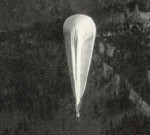
Historic stratospheric mission of Explorer II
On November 11, 1935, US Army Air Corps Captains Orvil A. Anderson and Albert W. Stevens reached a new record altitude in a pressurized gondola. The capsule built by Dow Chemical was carried by a 192-foot diameter helium filled balloon, with a volume of 3.7 million cubic feet and weighing 6,500 pounds. The couple departed from the Stratobowl, a natural depression in the Black Hills mountains in South Dakota not far from Rapid City at 7:01 a.m., MST, on November 11, 1935. At 11:40, Explorer II settled out at 72,395 feet. They were above 96% of the atmosphere, higher than anyone had ever ventured. From such a great height, Stevens reported they saw mostly patches of green or brown on the ground. Railroads were the only recognizable features along with larger farms which could be picked out by their rectangular patterns. During the flight which lasted 8 hours and 13 minutes, they recorded the first photographs that showed the curved top of the troposphere and the curvature of the Earth. Landing occured near White Lake, South Dakota, about 225 miles east of the Stratobowl at 3:14 pm.
As occured with explorer I the year before, the mission was sponsored by the National Geographic Society and the United States Army Air Corps. The record set by the mission would remain unbeaten until June 1957 when Joe Kittinger ascended to 95.200 ft. during Manhigh-I mission -
November 20 1953
First use of a movil unit to relay data at Holloman AFB
During a mission intended to sample CO2 and C14 in the stratosphere was used for the first time a specially built radio van as relay station. The balloon launched from Holloman AFB in New Mexico landed four hours later 12 miles N of Denver City, in Texas.
-
November 1 1956
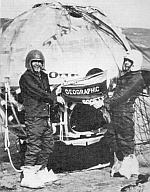
First manned mission of the Stratolab-High program
The 1st flight of the Stratolab-High program (the part of the Stratolab project that performed high altitude flights in a sealed capsule) was launched from the Stratobowl, a natural depression in South Dakota on November 8th, 1956. The mission which was piloted by Lt.Cmdrs. Malcolm D. Ross (USNR) and Morton Lee Lewis (USN) set a new altitude record of 76.000 ft. However they remained at this new unofficial manned balloon altitude record for only a few minutes before they suddenly began to drop. Assuming a ripped balloon, they radioed an emergency situation to ground control as they fell at 4,000 feet per minute, but both men agreed to stay with the balloon as it descended. Fortunately, after ditching over 200 lbs of hardware overboard, they controled the fall rate and finally landed safely near Bownlee, Nebraska.
-
November 16 1959
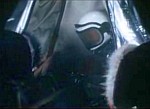
First stratospheric jump of program EXCELSIOR
As part of EXCELSIOR an U.S. Air Force program, which was designed to test whether pilots could survive high-altitude bailouts, in November 16, 1959 Captain Joseph W. Kittinger Jr was sent in a stratospheric balloon launched from New Mexico, to an altitude of 76,400 feet where he jumped to test a new automatic parachute device developed by Francis Baupre. However, the stabilizer parachute was deployed too soon, catching Kittinger around the neck and causing him to spin at 120 revolutions per minute. This caused Kittinger to lose consciousness, but his life was saved by his main parachute which opened automatically at a height of 10,000 feet.
-
November 28 1959
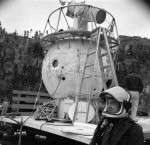
Fourth mission of the STRATOLAB HIGH project
Stratolab High IV was the fourth manned balloon mission of the StratoLab program developed by the US Navy. It used the same capsule as the previous flights, but with the addition of a 16-inch Schmidt infrared telescope on capsule's top. The mission crew was composed by Lt. Cmdr. Malcolm D. Ross and Charles B. Moore. The launch was performed on November 28, 1959 from the Stratobowl, a natural depression in South Dakota. After a nominal ascent the balloon reached an altitude of 81,000 feet and throughout the night, Moore used the telescope to look for water in the atmosphere of Venus. They landed the following afternoon near Manhattan, Kansas. That would be the last time the spherical capsule would be used in the program.
-
November 1 1962
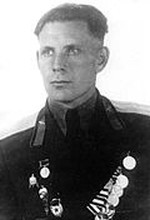
Tragic death of Peter Dolgov during VOLGA mission
VOLGA was a manned balloon mission aimed to test spacesuits and a new non-explosive type of Vostok ejection seat. The crew was composed by Major Yevgeny Andreev and Colonel Pyotr Ivanovich Dolgov. The aim of the mission was to ascend to 80.000 ft in a sealed capsule and there, perform a stratospheric jump. The balloon was launched from Volsk, near Saratov, in the Soviet Union on November 1st. 1962. Once altitude was reached, the first to leave the capsule using the new ejection system was Andreyev, followed minutes after by Dolgov whom would leave the capsule on his own. Apparently at the moment of the jump, Dolgov hit a protruding object near the border of the hatch, making a small hole in his helmet, but big enough to let the air and pressure of his Sokol suit to escape, killing him while falling. In december that year, the soviet politburó awarded posthumously to Dolgov with the title of "Hero of the Soviet Union" and the next year a park in the city of Dolgoprudny -home of the Soviet balloon program- was named after him.
-
November 26 1969
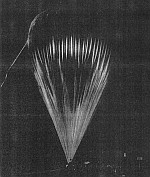
First launch of a stratospheric balloon in Argentina
In November 26, 1969 was launched from Paraná Air Base the first stratospheric balloon of great volume ever launched in Argentine. The balloon measuring six million cubic meter was launched by a National Center for Atmospheric Research (NCAR) team with support of the argentinian Comision Nacional de Investigaciones Espaciales (CNIE). The payload was composed by a gamma ray telescope developed by Dr. Robert C. Haymes of the Rice University and the aim of the flight was to study several radiation sources in the galactic center like CEN XR-4 and SCO XR-1.
-
November 1 1974
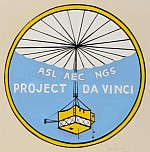
First flight of the DA VINCI project
Da Vinci were a series of balloon flights that combined science and original kinetic art, developed by aeronaut and plastic artist Vera Simons. She worked with Dr. Rudolf J. Englemann, a National Oceanic and Atmospheric Administration (NOAA) scientist and former Air Force meteorologist, and received funds from the National Geographic Society, Atomic Energy Commission, private companies, and the National Aeronautics and Space Administration (NASA). Simons spent two years designing and supervising the construction of a two-decker fiberglass gondola and polyethylene balloon. An authority on migration of lower-level atmospheric pollutants, Englemann assembled a package of experiments from 25 universities. The first Da Vinci flight was a 12-hour nighttime flight from Las Cruces to Wagon Mound, New Mexico, in November 1974. The flight collected detailed temperature and airflow data.
-
November 23 1979
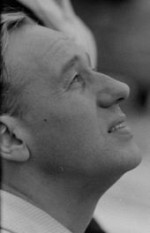
Otto Winzen dies
On November 23, 1979 Otto Christian Winzen a German-American aeronautical engineer which in late 40's started the modern era of scientific ballooning, whom is considered by many the father of the plastic balloon died at the age of 58. He was born on October 24, 1917 in Germany, living great part of his childhood in Cologne, but at the age of 20 he emigrated to the United States. There, he studied at the University of Detroit Mercy, obtaining a degree on Aeronautical Engineering. During his years at the University he would met two key figures in his life: the aeronaut Jean Piccard and through him to Vera Habrecht, whom would become his wife. The couple founded Winzen Research Inc. a balloon production company which would be one of the leader firms in the field during many decades, participating of many succesful research programs for the USAF and Navy. Also, during his life he participated as central speaker in many Symposia and Congress related to scientific ballooning and space activities. He was considered by many one of the most authoritative voices in the field.
Near the end of 70's decade, as a result of his deteriorated relationship with Marion, his second wife, and several changes made to its company, depression started to set in until on November 23, 1979, he committed suicide. Winzen was cremated and his ashes were placed in a niche at Resurrection Cemetery in Minnesota next to his second wife. -
November 10 1981
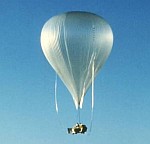
First successful crossing of the Pacific Ocean - Double Eagle V
Double Eagle V was a balloon mission piloted by Albuquerque balloonists Ben Abruzzo, Larry Newman, and Ron Clark, along with Rocky Aoki a japanese chef, who helped fund the flight. It departed from Nagashima, Japan on November 10, 1981, and landed in Mendocino National Forest in California 84 hours and 31 minutes later becoming the first balloon to make a successful crossing of the Pacific Ocean. Abruzzo and Newman had previously been two of the pilots of Double Eagle II, which three years before was the first balloon to cross the Atlantic. Double Eagle V failed to attract the same degree of media attention as the earlier flight, in part because it was overshadowed by the concurrent Space Shuttle Columbia mission STS-2.
-
November 1990
Last balloon launch campaign in Mendoza Airpark, Argentina
In November 1990, was held what would be the last balloon launch campaign from Aeroparque Mendoza. The aim was to study the mountain gravity waves produced by the presence of the massif of the Andes. The launches were made by the French CNES under the coordination of Hector Teitelbaum, researcher and director of the Laboratory of Dynamic Meteorology from France. After that, the Mendoza launch base would not be used for this activity again.
-
November 10 1992
Project ELBBO sets a new balloon flight record
On November 10, 1992 was launched from Dunedin, New Zealand the second of five superpressure balloons that would circle the southern hemisphere as part of ELBBO (Extended Life Balloon Borne Observatories Program). Each balloon carried a payload aimed to perform simultaneous in situ measurements of the stratospheric electrical conductivity developed by Dr. Robert H. Holzworth of the Washington University. The balloons -designed and manufactured by Raven Industries Inc.- were of spherical superpressure type measuring 70 ft of diameter. This particular flight endured 124 days aloft, setting a new duration record for this superpressure balloon size. The ELBBO experiment allowed to obtain one of the most comprehensive data sets on the stratospheric electrical conductivity.
-
November 25 2002
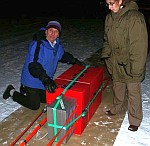
First flight of the BEXUS student balloon program
On November 25, 2002 departed from ESRANGE balloon base near Kiruna, Sweden the first balloon of a initiative called BEXUS (Balloon Experiment for University Students). The initial aim was to allow students at Kiruna's different space related educations to send their own designed and built experiments with a balloon. First flights were performed to take advantage of available payload space during technological flights used to test ESRANGE's balloon-borne systems but with the time, the program would evolve a lot. Currently is an ESA / DLR initiative and involving experiments and students of every corner of the European Union and performing two balloon flights every October.

